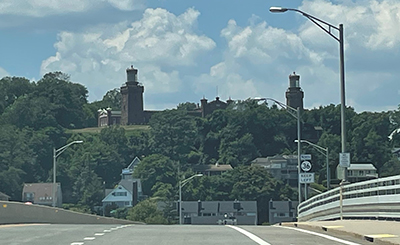
The Twin Lights historic site at Highlands, New Jersey is among the most high-profile places for historic preservation in New Jersey. The significance of the building is intertwined within the surrounding landscape and the site’s historic use. The current lighthouse was erected in 1862 on a highpoint overlooking the Atlantic Ocean and into to the New York harbor, serving as an important navigation point. Historic images show that the slope facing the ocean was cleared to be free of trees, ensuring that this navigational landmark was visible without obstruction.
The state of New Jersey (NJDEP Parks Department) took over the property after the light house was decommissioned in 1953. It was later registered as a National Historic Landmark in 2006. The Lighthouses soon became a tourist attraction, telling the narrative of its significant naval history and offering stunning views of New York City, Sandy Hook, and the Atlantic Ocean.
The landscape maintenance of the site was limited to the immediate vicinity of the building, allowing significant tree growth to occur on the slope. If nothing continues to be done, the lighthouse will eventually disappear behind the trees and the historic viewshed out to the ocean will cease to exist. Furthermore, the trees create a disconnect between the visitor experience and the narrative of naval history as they continue to grow. This will continue to depreciate its historical significance to visitors if the view is not restored.
The CUES team is working in close collaboration with the Twin Lights Historical Society, NJDEP, and New Jersey Historic Trust, on a View Shed Historic Site Management Plan that will integrate the goals of historic preservation with the requirements of resilient and sustainable vegetation management. We are currently working on a summary of the evolution of the historic cultural landscape along with an assessment of the current landscape conditions, which will inform a preservation master plan to maintain the site’s significance over time.
In spring semester 2022, the site was also topic for a landscape architecture design studio. These student designs are truly academic, meaning that they explore new possibilities for the site that are not feasible, but open new questions for further explorations.


